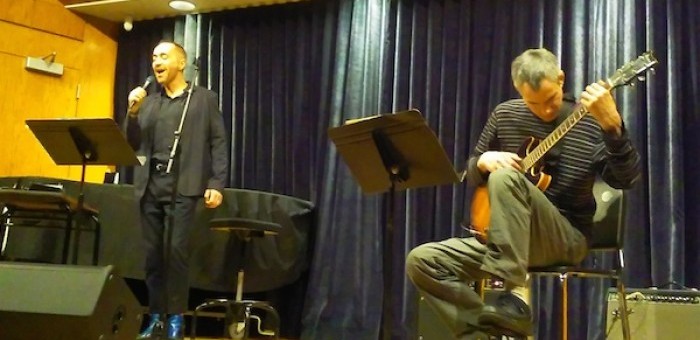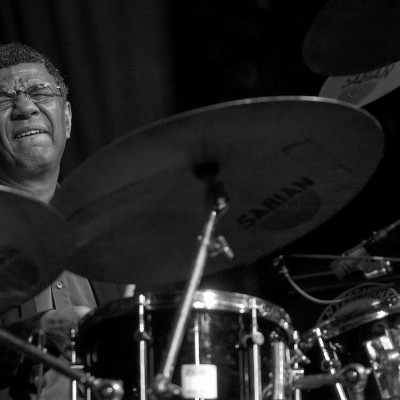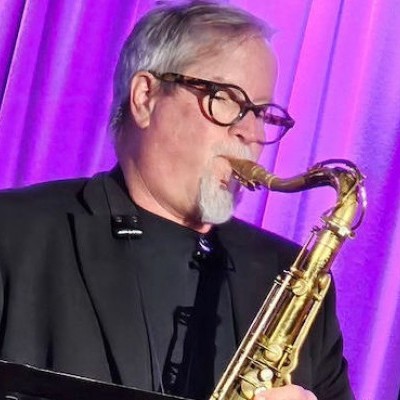Oct 28, 2025 10:47 AM
In Memoriam: Jack DeJohnette, 1942–2025
Jack DeJohnette, a bold and resourceful drummer and NEA Jazz Master who forged a unique vocabulary on the kit over his…

Theo Bleckmann (left) and Ben Monder perform at Western Michigan University in Kalamazoo, Michigan, on April 9. (Photo: John Ephland)
(Photo: )Singer Theo Bleckmann and guitarist Ben Monder performed before an intimate audience at Western Michigan University’s Dalton Center Recital Hall in the second of two shows April 9, extending a musical relationship that goes back more than 20 years.
Their set demonstrated a knack for blurring the boundaries of song, reinventing what it means for a singer and guitarist to team up in the 21st century. Using electronic looping and processing to create selective choral and textural effects, Bleckmann had his hands (or voice) full as Monder’s regularly thunderous and full-bodied guitar filled the room.
Not surprisingly, the overall atmosphere was dreamy, with occasional nods to something resembling grunge. Bleckmann’s voice and Monder’s guitar, for those familiar with each artist’s repertoire, seem well suited for each other. That was certainly the case this evening.
Granted, there were rough edges along the way, but jazz, being an improvised music, is sometimes the better for it. More than a few audience members must have been grateful that these New York-based artists came to town to deliver a full-hearted performance—honestly and forthrightly.
On the whole, the music appeared sketchy, despite the presence of music stands. In fact, the stands seemed to be a way into hearing the music visually, the listener perhaps wondering how it all was put together. Bleckmann was riffing, scatting and singing wordless vocals, while Monder’s guitar emitted mashups of eloquence with sheer sonic blasts of controlled feedback. Nonetheless, the guitarist’s fulsome, finger-picking style resulted in soaring lines that gave Bleckmann a large canvas on which to project his artistry. And with crescendos building, there still tended to be melodic lines one could hear streaming through the periodic blazes.
For his part, Bleckmann’s use of electronics and tape loops at times sounded orchestral, creating angelic unison lines with the guitarist. By and large, the music sidestepped meter, opting for more floating pulses that suggested a natural heartbeat, even if it was an irregular one.
The performance was also marked by shifts in intensity. There were moments when Monder was literally pulling his strings off the body of his electric guitar, hands flying. Elsewhere, Bleckmann would tilt his face skyward and sing a serene note with eyes closed, and Monder, just as calmly, letting his guitar softly grind.
It was during these rare episodes that one might reconsider these artists’ collective and individual relationships to the jazz canon, and the amount of research each has done on all manner of musical forms, including pop and classical, and how it all informs their work together. One could enjoy knowing that some of these pieces were commissioned by the Dance Center of New York City.
In the end, the duo’s reaching, albeit uneven performance resulted in the creation of an enveloping, sometimes luminous world. An intimate musical conversation, this spacious musical dialog was, paradoxically, full of content, with voices folding into each other in unsuspecting ways.
Their mostly modal set climaxed with more reverb as the duo suddenly turned up the heat, the two becoming unmoored, musically darting to and fro. Finally centering around a pulse (3/4) with lyrics (including the Beatles’ “Norwegian Wood”), Bleckmann and Monder’s freewheeling crescendos of alarming frenzy ended in, of all things, a major key!
(Note: To read a review of Theo Bleckmann’s performance at the 2016 Winter Jazzfest, click here.)
—John Ephland

Jack DeJohnette boasted a musical resume that was as long as it was fearsome.
Oct 28, 2025 10:47 AM
Jack DeJohnette, a bold and resourceful drummer and NEA Jazz Master who forged a unique vocabulary on the kit over his…

“I’ve told students, ‘I don’t mind if you use AI for this or that project,’” says MIT’s Pascal Le Boeuf. “‘But you need to tell me.’”
Sep 18, 2025 11:14 AM
A standard joke when it comes to discussing artificial intelligence, or AI, is that it’s developing so rapidly that…

Chuck Manning Works for NASA … and plays jazz.
Sep 18, 2025 11:23 AM
Congratulations! After years of study, you’ve earned your degree in jazz performance. But let’s face it: Making a…

Always a sharp dresser, Farnsworth wears a pocket square given to him by trumpeter Art Farmer. “You need to look good if you want to hang around me,” Farmer told him.
Sep 23, 2025 11:12 AM
When he was 12 years old, the hard-swinging veteran drummer Joe Farnsworth had a fateful encounter with his idol Max…

“Make time and energy to meet people and make friends,” suggests Millie Ahearn, a student at DePaul University.
Sep 18, 2025 11:32 AM
For many students, the transition into a collegiate jazz program can feel overwhelming — new peers, unfamiliar…